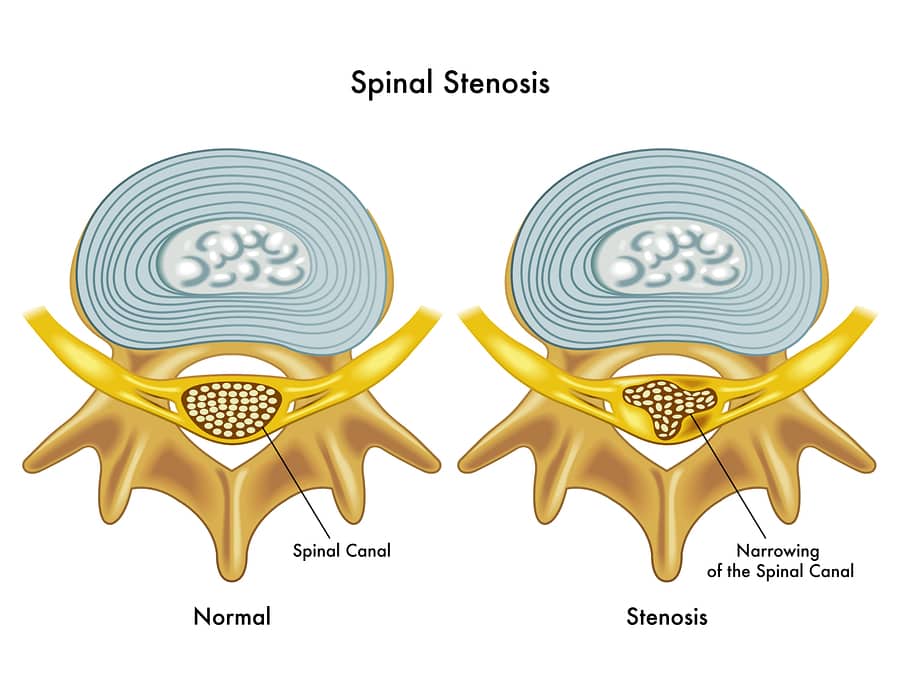On This Page[Hide][Show]
Are you or someone you know struggling with cervical spinal stenosis? The impact of this condition on daily life can be overwhelming, leading many to question whether spinal stenosis can qualify a person to receive long-term disability insurance or Social Security Disability Insurance benefits.
Is Cervical Spinal Stenosis a Disability?
Cervical spinal stenosis is a medical condition in which the spinal canal narrows, putting pressure on the spinal cord and nerves and leading to discomfort in the neck. The term “stenosis” originates from a Greek word that means “choked.” In the case of this condition, the nerves in the spinal cord are essentially “choked off,” resulting in symptoms like leg discomfort, walking difficulties, a tingling sensation, muscle weakness, and numbness that can extend from the neck and back to the legs.
Because cervical spinal stenosis is a degenerative illness, a person’s condition will continue to deteriorate over time. The resulting pain, numbness, tingling, or weakness can impact a person’s ability to carry out meaningful employment.
This condition is generally associated with aging, and most individuals diagnosed with spinal stenosis are above the age of 50. However, younger people can also develop spinal stenosis as a result of spinal cord curvature or injury. If the condition is severe enough to inhibit work activity, they may be eligible for disability assistance. The younger the individual, the less likely they are to qualify for benefits.
Several medical conditions, including bulging or herniated discs, degenerative disc disease, bone spurs, arthritis, scoliosis, and scar tissue, can cause or contribute to a spinal stenosis diagnosis.
Is Spinal Stenosis a Permanent Disability?
Spinal stenosis can cause permanent damage to your spine. Stenosis can occur in the cervical or c-spine (neck) and lumbar (lower back) areas of the spine. It can cause muscle weakness and pain or cramping extending from the buttocks down through the leg. It may also cause bladder and bowel issues.
What are the Symptoms of Cervical Spinal Stenosis?
The intensity and manifestations of stenosis vary from person to person. For some, symptoms like pain, weakness, and numbness may fluctuate. They may experience periods of minimal pain interrupted by flare-ups due to factors such as physical exertion.
Typical symptoms of spinal stenosis include:

- Limb weakness
- Neck discomfort
- Unusual reflexes
- Pain radiating to the arms
- Sensory deficiencies
- Muscle atrophy
- Leg discomfort
- Difficulty walking
To qualify for disability benefits, your doctor must detail your condition and its associated limitations in your medical records.
How Is Spinal Stenosis Diagnosed?
If a patient presents with leg discomfort (with or without back pain) that worsens with walking, or if they experience instances of leg weakness or numbness, a doctor will typically order imaging tests like x-rays, MRI scans, or CT scans. Depending on the results, the diagnosed spinal stenosis may be classified as:
- Lateral Stenosis: The most common form, which occurs when a bulging disc, herniated disc, or bone spur compress a nerve root exiting the spinal column.
- Central Stenosis: This occurs when the back’s central canal is compressed.
- Foraminal Stenosis: Occurs when nerve roots in the lower back are pressed upon and trapped by a bone spur in the opening where the nerve root leaves the spinal canal.
Treatment options may include anti-inflammatory pain relievers, physical therapy, steroid injections, chiropractic care, and, in severe cases, surgery.
Understanding the Impact of Cervical Spinal Stenosis on a Person’s Ability to Work
Many individuals with cervical spinal stenosis feel comfortable while seated but experience symptoms when standing upright. This is due to the limited space available for nerve roots, which can block blood flow around the nerve, irritating it and causing discomfort when standing.
Qualifying for Long-Term Disability Benefits
To qualify for long-term disability benefits, you must meet specific medical criteria. For spine disorders, this typically includes severe, chronic pain and limited movement or walking ability that results in severe pain. Proving your condition will likely require medical records, lab test results, and potentially a questionnaire completed by your doctor.
Your long-term disability (LTD) insurance provider will assess whether your condition prevents you from performing your occupation. If they determine your condition is severe enough to prevent you from gainful employment, you may be eligible for LTD benefits.
These records should include a confirmed diagnosis, the frequency and severity of your symptoms, MRI or CT scans documenting spine degeneration, your treatment history, and other test results like imaging studies or those measuring the range of motion in your spine.
Evaluating Disability for Persons with Cervical Spinal Stenosis
The insurance company will assign an adjuster to your case. They should consider all available evidence and the illness’s impact on each affected body system. They may have your file reviewed by medical professionals to provide an opinion on your impairment level. If they need more information, they will contact you or request it from an independent medical source.
While a diagnosis can be reached based on your symptoms (after other disorders have been ruled out), your disability must be substantiated by medically acceptable clinical and laboratory findings. Simply stating your symptoms or diagnoses is insufficient to be approved for long-term disability benefits.
How the Insurance Company Assesses Your Residual Functional Capacity
In light of your documented symptoms, the insurance company may develop a Residual Functional Capacity (RFC) profile for you that states, for example, that due to persistent leg pain or weakness, you may need to take frequent breaks throughout the day. Because most employers would not accommodate this limitation, it would be difficult for you to obtain and maintain most jobs.
If you suffer from documented leg pain, numbness, or weakness from your spinal stenosis, your RFC may include limitations on certain work-related physical activities as well, such as walking distances or lifting anything over 10 pounds that could further strain the back. This limitation would prevent you from doing jobs that require physical exertion, such as factory work, warehouse work, and most janitorial positions.
Living with chronic discomfort from cervical spinal stenosis can also cause mental health problems such as depression or anxiety. If you are receiving mental health treatment, you should ask your treating physician (your psychiatrist or psychologist) to fill out an RFC form that details his or her opinions of your work-related limitations.
Working with a Long-Term Disability Insurance Attorney
Working with an experienced long-term disability lawyer can greatly increase your chances of a successful claim. They can help you gather your medical records, offer legal advice, and prepare a custom RFC form for your doctors to complete. They will know how your insurance provider handles claims and can assist you in preparing paperwork and collecting crucial evidence.
We have a “No Recovery, Zero Fee Guarantee.” This means our clients only pay a fee when disability benefits are recovered.

Social Security Disability Benefits
Patients who suffer from cervical stenosis may qualify for Social Security Disability Insurance (SSDI) benefits. Before qualifying for Social Security Disability, the Social Security Administration must determine your eligibility for Social Security. A claimant must meet the medical and non-medical requirements to be approved for benefits.
Those who have worked five out of the last ten years may have the work credits needed to qualify for SSDI benefits. The Social Security Administration also has the Supplemental Security Income benefits program for those who have not worked five out of the last ten years, but the claimant must meet strict non-medical requirements regarding household income. As for medical requirements, you must either meet a disability listing or prove that your functional limitations prevent you from performing substantial gainful activity.
What About Lumbar Spinal Stenosis?
Lumbar spinal stenosis is another form of stenosis that might qualify for long-term disability insurance and Social Security Disability benefits if the claimant cannot work due to the resulting symptoms and limitations. Cervical and lumbar stenosis are both spine disorders, but the associated symptoms and limitations vary somewhat. If you have lumbar spinal stenosis, we encourage you to read our article about lumbar spinal stenosis.
Work with an Experienced Attorney
We have experience handling claims with New York Life (formerly Cigna), Hartford, Lincoln, MetLife, Prudential, Reliance Standard, Unum, and many other disability insurance companies. We can help you evaluate your disability claim to determine eligibility for disability benefits, how to move forward with the process, and how to increase your chance of being approved.
If your disability claim has been wrongfully denied or terminated, and you’d like to speak to an experienced attorney about your degenerative condition and how it may be impacting your ability to work, call us at (888) 321-8131 to schedule a free consultation to discuss your claim.

